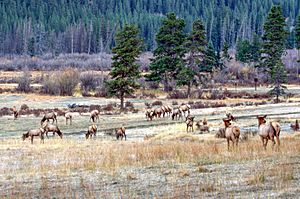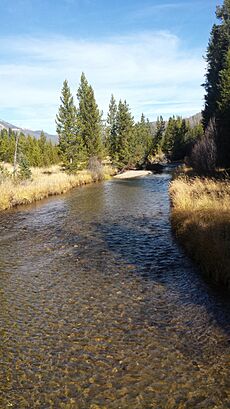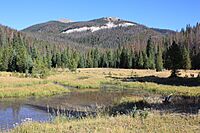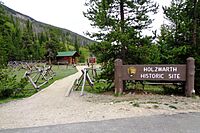Kawuneeche Valley facts for kids

The Kawuneeche Valley, also known as Coyote Valley, is a beautiful marshy valley where the Colorado River begins. You can find it on the west side of Rocky Mountain National Park in Colorado. The valley stretches mostly from north to south.
Kawuneeche means "valley of the coyote" in the Arapaho language. There's even a Coyote Valley Trailhead nearby on US Route 34. Coyotes still live here, along with amazing animals like wapiti (elk), mule deer, and mountain lion. You might also spot moose, which were brought to the area in 1978.
The famous Trail Ridge Road runs through the main part of the valley. This road is the highest paved road that stays open continuously in the United States!
Contents
Wildlife and the Environment

A long time ago, between the 1890s and 1930s, a water canal called the Grand Ditch was built. This canal changed the valley by lowering the water level and stopping big floods. The Grand Ditch collects water from streams in the Never Summer Mountains. It's like a giant rain gutter that sends water to the other side of the Continental Divide. This means less water flows down into the Kawuneeche Valley.
In 2003, the Grand Ditch broke, causing a lot of damage to the upper valley. The company that owns the ditch had to pay a large amount of money to help fix the park. This canal also makes the Kawuneeche Valley look less natural.
Animals Return to the Valley
Elk (also called wapiti) were brought back to the Colorado River Valley in the mid-1910s. They used to live here but had disappeared.
Moose were reintroduced by wildlife officials in the 1970s. They were brought to North Park, which is close to Rocky Mountain National Park. Before this, moose were rarely seen in Colorado. These large, solitary animals usually wander alone from places like Wyoming or Utah.
In 1978 and 1979, 22 moose were moved from Utah and Wyoming to an area near Rand. This area is just west of the Never Summer Mountains. Today, the Kawuneeche Valley is a great home for moose. You can even see them sometimes on the east side of the Continental Divide.
Challenges for Plants and Animals
There are now so many large plant-eating animals, like elk and moose, in the Kawuneeche Valley. They eat a lot of the willow plants and other vegetation. This causes problems for other animals that depend on these plants. Elk are very common, but moose are more picky eaters. About 91% of what moose eat in the summer is willow!
The valley also faces other challenges. The Grand Ditch takes water away, leading to drought. There are also fewer beavers, which help keep the water healthy. Plus, a native fungus is spreading, carried by a bird called the sapsucker. This fungus kills the stems of willow plants.
All these things make it hard for willows to grow back. Their numbers have gone down, and only a few willow plants produce seeds. Because North American beavers rely on willow twigs and bark, their population has also declined in the Kawuneeche Valley. Beavers and willows actually help each other, so this is a big problem.
Two types of bark beetles, the mountain pine beetle and the spruce beetle, are also causing trouble. In recent years, these beetles have destroyed many trees on the western side of Rocky Mountain National Park.
Fish in the River
Good news for the native Colorado River cutthroat trout! Thanks to scientists, these fish are making a comeback. However, other fish like brook trout, rainbow trout, and Yellowstone cutthroat trout were brought here and now compete with the native fish.
The Grand Ditch also allowed fish to swim between different river systems. This mixed up the genes of two native trout types: the greenback cutthroat trout from the eastern side of the Rockies and the Colorado River cutthroat trout from the west.
Exploring History
The Kawuneeche Valley is home to several interesting historical places:
- Trail Ridge Road: This famous road is listed on the U.S. National Register of Historic Places.
- Grand Ditch: The water canal we talked about earlier is also a historic site.
- Lulu City and Gaskil: These were old mining towns from the 1880s. People lived there for a short time during a mining boom, but then the towns were abandoned.
- Dude ranches: These were places where people could stay for vacations, often to experience life on a ranch.
- The Phantom Valley Ranch was a famous hotel established in the 1910s.
- The old Holzwarth family's place is now called the "Never Summer Ranch." It has several cabins and started being used in 1919.
Weather in the Valley
Harbison Meadow is a weather station in the Kawuneeche Valley. It's located just north of the visitor center. The valley has a subalpine climate, which means it has long, cold winters and short, mild summers.
| Climate data for Harbison Meadow (RAWS), Colorado, 2003–2020 normals: 8600ft (2621m) | |||||||||||||
|---|---|---|---|---|---|---|---|---|---|---|---|---|---|
| Month | Jan | Feb | Mar | Apr | May | Jun | Jul | Aug | Sep | Oct | Nov | Dec | Year |
| Mean daily maximum °F (°C) | 30.7 (−0.7) |
33.9 (1.1) |
42.8 (6.0) |
48.8 (9.3) |
57.7 (14.3) |
70.4 (21.3) |
75.8 (24.3) |
73.1 (22.8) |
66.8 (19.3) |
52.8 (11.6) |
40.8 (4.9) |
30.4 (−0.9) |
52.0 (11.1) |
| Daily mean °F (°C) | 14.5 (−9.7) |
18.3 (−7.6) |
25.9 (−3.4) |
33.7 (0.9) |
42.4 (5.8) |
51.3 (10.7) |
56.6 (13.7) |
54.0 (12.2) |
47.2 (8.4) |
36.6 (2.6) |
25.2 (−3.8) |
15.2 (−9.3) |
35.1 (1.7) |
| Mean daily minimum °F (°C) | −1.9 (−18.8) |
2.7 (−16.3) |
9.0 (−12.8) |
18.8 (−7.3) |
27.0 (−2.8) |
32.3 (0.2) |
37.3 (2.9) |
34.9 (1.6) |
27.6 (−2.4) |
20.4 (−6.4) |
9.5 (−12.5) |
−0.1 (−17.8) |
18.1 (−7.7) |
| Source: XMACIS2 | |||||||||||||




